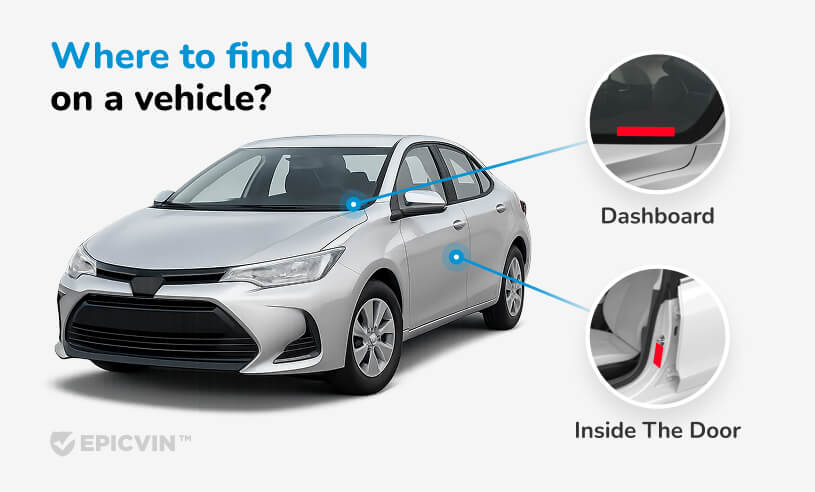
How to Read a VIN Number Like a Pro
From understanding the VIN number breakdown to uncovering a vehicle’s history,...

Free Chevrolet VIN Decoder! 🚗 See specs, build sheet, recalls basic history—no sign-up. 🛡️✅ Need accidents, mileage, title? Upgrade in one click.
Looking for the VIN?
Here is there you’ll find it:

A vehicle identification number (VIN) is a unique 17-character sequence. It serves as your car's fingerprint. This sequence contains crucial information about the vehicle manufacturer, specifications, and history for informed purchasing decisions. A VIN Decoder tool helps unlock and interpret these coded details to reveal comprehensive vehicle information.
Get instant vehicle information in four simple steps with our VIN decoder.

Locating your VIN number is essential for using our Chevrolet VIN decoder. Here are the most common location points where you can find your vehicle identification number:
Primary VIN Locations:
Additional VIN Locations: Depending on your Chevrolet, you may also find the VIN in these locations points:
Once you locate your number, simply enter it into our VIN decoder. Get instant access to your car's specifications and history.
| Key Risk | Impact on Buyers |
|---|---|
| Vehicle Theft (21,666 Silverado thefts) | Requires comprehensive insurance and an immobilizer |
| Major Recalls (1.05M+ automobiles affected) | Check the NHTSA; verify repairs completed |
| Fatal Accidents (Corvette 2018-2022: 13.6 deaths per 1B miles, 4.8x above average) | Higher insurance premiums and driver risk; proper tires and active safety systems are crucial |
| Depreciation (Silverado -39% over 5 years) | Factor into long-term ownership costs |
| Odometer Fraud (2.14M vehicles affected) | Verify mileage through vehicle history reports |
| Flood/Salvage Titles (454K flood-damaged) | Review the vehicle's title history carefully |
How to Reduce Risks: Check VINs through official databases and the EpicVIN reports. Highlight accidents, mileage tampering, salvage title, and open recalls.
Based on our analysis of numerous searches and vehicle history reports, here are the most frequent problems affecting Chevrolet cars:
| Issue | Affected Models, Symptoms, Average Repair Cost |
|---|---|
| 8-Speed Transmission \"Shudder\" (8L45/8L90) | Silverado, Colorado, Camaro, Corvette, Tahoe (2015-2019) — vibration and harsh shifts on 30-60k miles; flush/ATF $450-650, valve body ≈ $1,550, rebuild/replacement ≈ $4,450 |
| Lifter Collapse 5.3/6.2 V8 | Silverado, Tahoe, Suburban, Sierra (2014-2025) — engine ticking, misfires from 20k miles; lifter module and cylinder head replacement $4,000-9,000, average ≈ $7,800 |
| Infotainment System Failures (PIT6362) | 2024-2025 trucks and SUVs — black screen, restarts, audio loss within 10k miles; OTA patch free, hardware replacement ≈ $1,200 |

Every vehicle identification number (VIN) follows a standardized format. Its specific positions contain different types of information.
Example of Chevrolet VIN breakdown: 1GCEK19T77Z123456
| Symbols | Sample | What It Reveals |
|---|---|---|
| 1 | 1 | The United States as the country of origin |
| 2 | G | General Motors as a manufacturer |
| 3 | C | Chevrolet truck division |
| 4-8 | EK19T | GVW 6,001-7,000 lbs, 4WD config, 1500 series, extended cab, 5.3L V8 |
| 9 | 7 | Check digit for validation |
| 10 | 7 | 2007 model year |
| 11 | Z | Assembly plant code |
| 12-17 | 123456 | Individual serial number |
Year 2012
Make Chevrolet
Model Cruze
Fuel Type Gasoline
Engine 1.4L In-Line LUJ
Made in USA
Since 2010, our data team has decoded upward of 40 million Chevrolet VINs. We've cross-checked each one against NMVTIS, state DMVs, and live auction photo feeds. Government records and real-world imagery let shoppers spot hidden damage or unrepaired recalls. Turn a quick VIN search into a serious layer of protection.Alex Black, CMO, EpicVIN
Yes. EpicVIN provides basic VIN decode at no charge, instantly showing original specs, trim level, and assembly plant. You only pay to unlock the full history report with accidents, mileage records, and title events.
Enter your sequence into EpicVIN to see active Chevrolet campaigns with NHTSA numbers. Here are recent examples:
– NHTSA 25V274000 (597,571 cars with 6.2-L V8 motor issues).
– NHTSA 24V797000 (461,839 diesel trucks with transmission defects).
The sequence appears in the upper-left corner. It's placed above the barcode on factory Monroney stickers. Most stickers also repeat the VIN along the bottom edge next to pricing details.
EpicVIN interprets all modern 17-character VINs (1981-present). It reveals year, body type, trim, and assembly plant. Review the Silverado, Colorado, Camaro, Corvette, Suburban, Tahoe, Equinox, Trailblazer, and Bolt EV cars.
EpicVIN pulls live data from different reliable sources. These are state DMV feeds, insurance databases, auction lanes, GM & NHTSA recall APIs, and service networks. The website provides accurate build specs and instant red-flag alerts.
Note: The Silverado 1500 was the third-most-stolen vehicle in America, with 21,666 thefts reported.
Discover expert tips, news and advice on buying and maintaining used vehicles

From understanding the VIN number breakdown to uncovering a vehicle’s history,...

This comprehensive guide explains the importance of VIN in determining your ve...

Here are the top four-seat convertibles available in 2023.